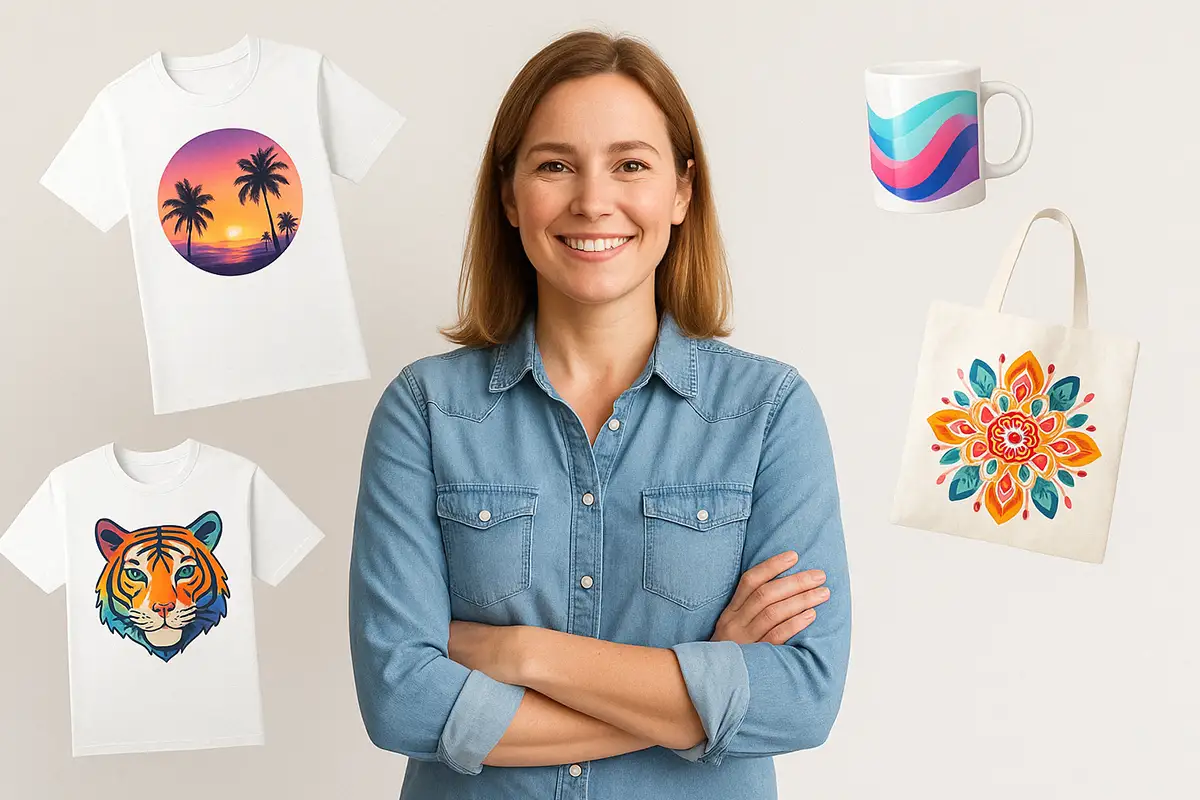The print-on-demand (POD) industry has revolutionized the way entrepreneurs approach e-commerce, offering unparalleled flexibility and creativity in product design and sales. This business model allows individuals and businesses to create custom products per order, eliminating the need for large inventory and reducing upfront costs.
The key to success in this vibrant market lies not just in understanding the POD process but crucially in selecting the right niches and products. This article aims to guide both beginners and seasoned entrepreneurs through the essential steps of identifying profitable niches and products, focusing on trend analysis and understanding competition.
ALSO READ: What is Print-on-Demand? A Beginner’s Guide
Understanding Print-on-Demand Market Dynamics
Print-on-demand is more than just a printing technology; it’s a dynamic business model that intertwines with global e-commerce trends and consumer behaviors. In POD, products are created and shipped only after a sale, which means product choices can be more diverse and tailored to specific customer segments. However, the success of a POD business heavily relies on the entrepreneur’s ability to identify and capitalize on profitable niches.
These niches are specific market segments with a dedicated and interested audience. Choosing the right niche involves understanding what people are passionate about, what they need, and what they are talking about. It’s not just about selling a product; it’s about fulfilling a unique demand or interest that isn’t being met by mainstream retailers.

Free Niche Selection Checklist
Save this handy checklist that will help you organize and validate your niche choices and ideas.
Trend Analysis for Niche Selection
Identifying emerging trends is crucial for staying ahead in the competitive POD landscape. Trend analysis involves researching and predicting shifts in consumer interests and behaviors, which can lead to the discovery of lucrative niches. Here are some steps to effective trend analysis:
- Stay Informed: Regularly follow market research reports, social media platforms, and consumer forums to gauge changing interests and preferences.
- Use Analytical Tools: Leverage tools like Google Trends, BuzzSumo, or social listening platforms to track popular topics and keywords.
- Observe Industry Leaders: Watch what top players in the POD space are doing. Their new product lines and marketing strategies can provide valuable insights.
Example: “The Rise of Eco-friendly Yoga Mats”
Consider the recent surge in eco-consciousness among consumers. A savvy entrepreneur might notice an increasing discussion around sustainability in fitness forums and social media. By combining this trend with the popularity of yoga, a unique niche emerges: eco-friendly yoga mats. These mats cater to environmentally conscious yogis who are willing to pay a premium for products aligning with their values. This example illustrates how trend analysis can lead to the discovery of a profitable and purposeful niche.
Analyzing the Competition
Once you’ve identified a potential niche through trend analysis, the next crucial step is to understand your competition. Analyzing competitors isn’t just about knowing who they are; it’s about understanding their strategies, strengths, and weaknesses. This knowledge can help you find a unique angle or gap in the market that you can exploit. Here’s how to conduct a thorough competition analysis:
- Identify Key Players: Look at who is currently dominating your chosen niche. What products are they selling, and what are their bestsellers?
- Study Their Marketing: Observe how these competitors market their products. Pay attention to their social media presence, content marketing, and customer engagement strategies.
- Analyze Product Quality and Pricing: Compare their product quality, pricing, and design options. This can help you position your product competitively.

Case Study: “How Petogram Found Success with Custom Pet Portraits”
Petogram, which noticed the growing trend of pet owners wanting to immortalize their pets through art. While the market had several players offering generic pet products, Petogram decided to specialize in custom pet portraits. They analyzed their competitors and realized that most were either too expensive or lacked personalization options. By offering high-quality, affordable, and deeply customizable portraits, Petogram successfully captured and led this niche, standing out in a crowded marketplace.
Selecting Your Products
With a clear understanding of market trends and competition, it’s time to select your products. The ideal POD products should not only resonate with your target audience but also align with your brand’s values and capabilities. Here are some key considerations:
- Match Product with Niche: Ensure that your product is a natural fit for your chosen niche. For instance, eco-friendly yoga mats are perfect for the environmentally conscious fitness enthusiast.
- Consider Production and Shipping: Understand the logistics of producing and shipping your product. It should be cost-effective and maintain quality.
- Unique Value Proposition (UVP): Your product should have a clear UVP. Whether it’s customization, quality, or design, it should offer something that competitors don’t.
By carefully selecting products that meet these criteria, you can create a strong product line that appeals to your target market and stands out from the competition.
Actionable Tips for Maximizing Profits
Having identified a promising niche and selected suitable products, the next step is to maximize your profits. Here are some actionable tips to help you achieve this:
- Optimize for SEO: Ensure your product titles, descriptions, and online content are optimized for search engines to increase visibility.
- Leverage Social Media: Use social media platforms to promote your products. Tailor your message to resonate with your target audience and encourage sharing.
- Offer Bundles and Discounts: Increase the average order value by offering bundled products or discounts on multiple purchases.
- Collect Customer Feedback: Use customer feedback to refine your products and marketing strategies continually. This can lead to repeat business and referrals.
Conclusion
The print-on-demand business model offers a fantastic opportunity for entrepreneurs to explore creative and niche markets with relatively low risk. By understanding market dynamics, conducting thorough trend analysis and competition research, and carefully selecting and marketing your products, you can build a profitable POD business. Remember, the key to success lies in staying informed, being adaptable, and always focusing on what your customer needs and wants.
ALSO READ: Printful vs. Printify: What Does Reddit Say?



Pingback: Top 10 Niches for Print-on-Demand in 2024 • Inky Dollar
Comments are closed.